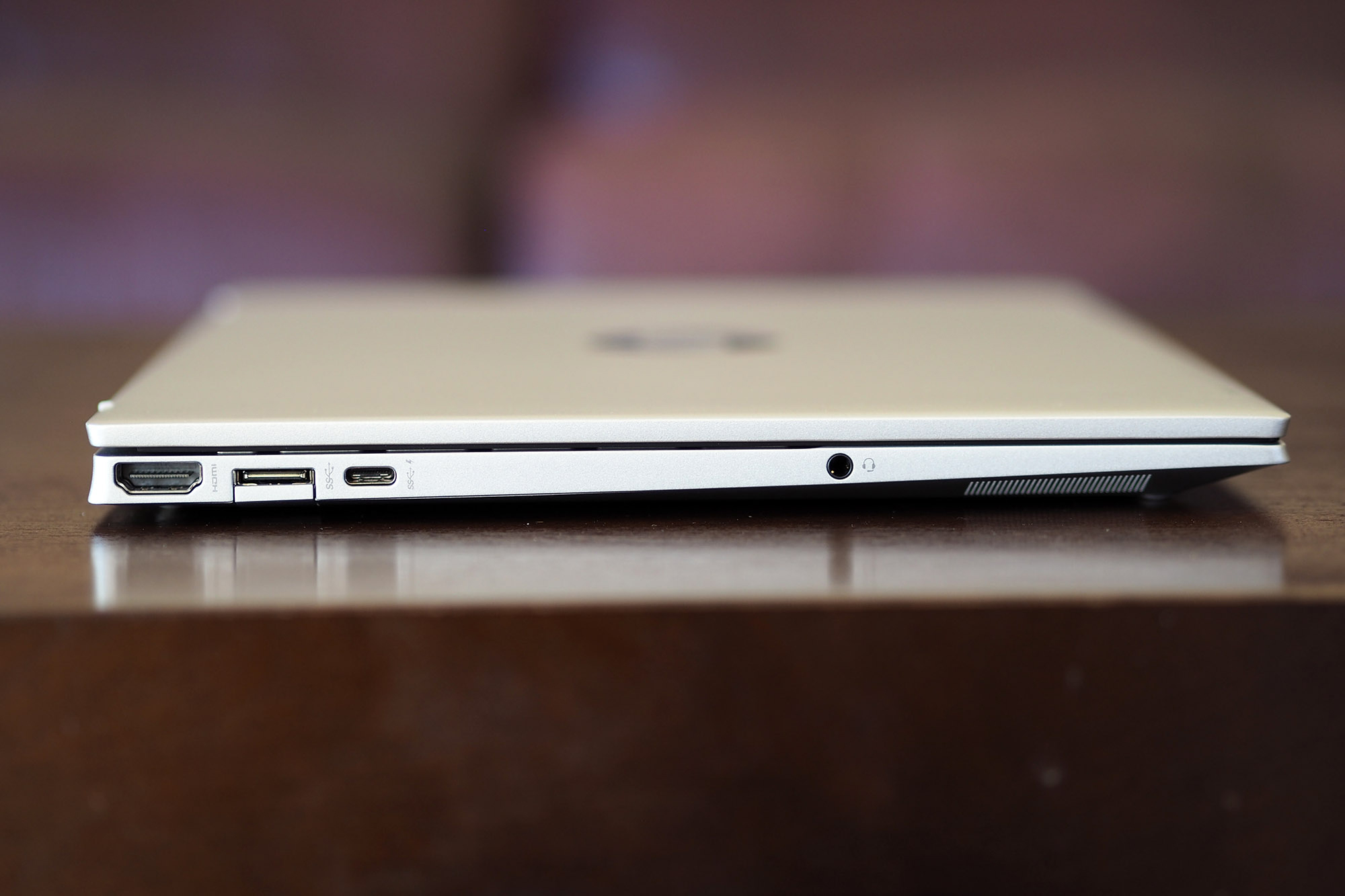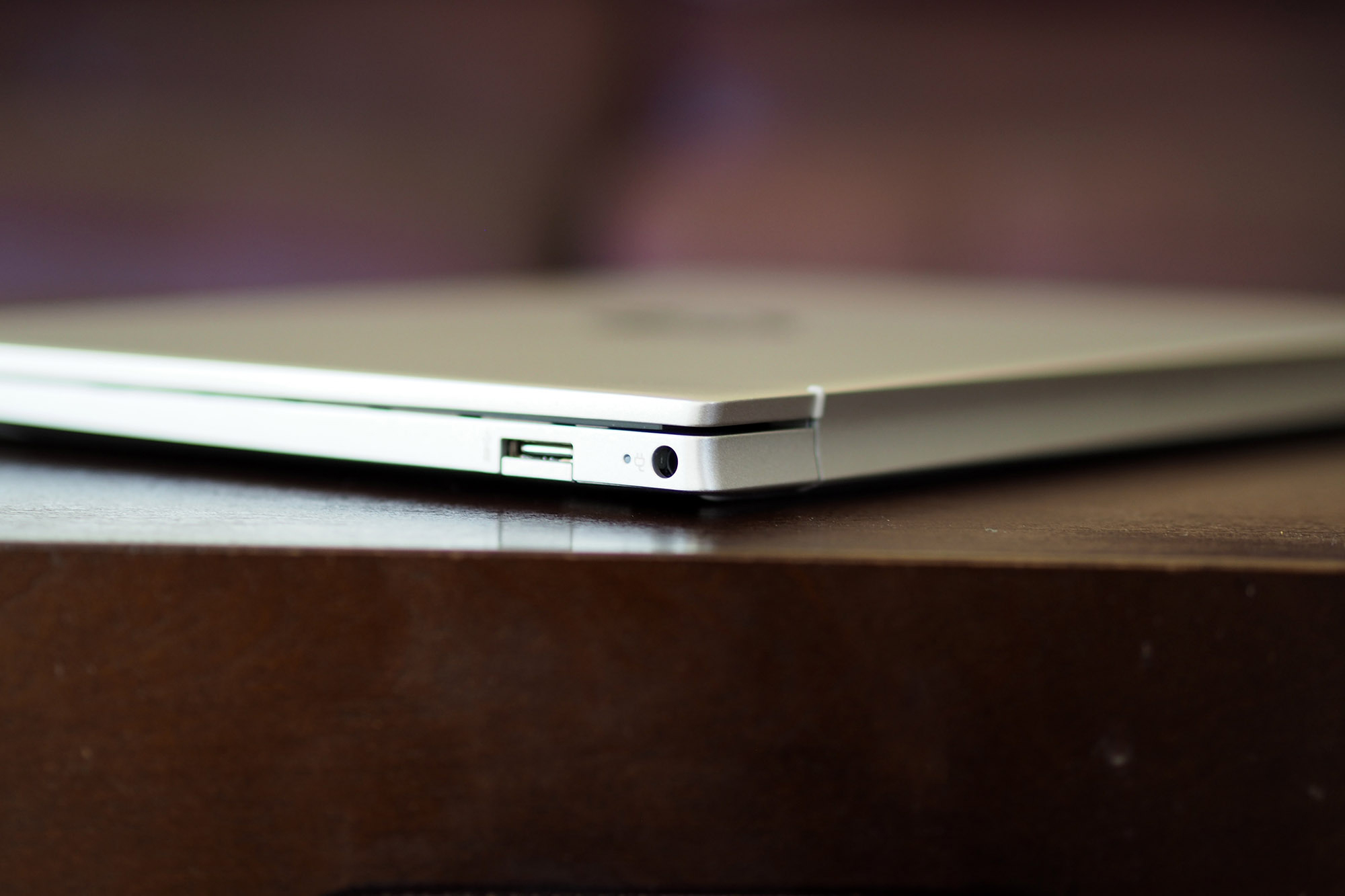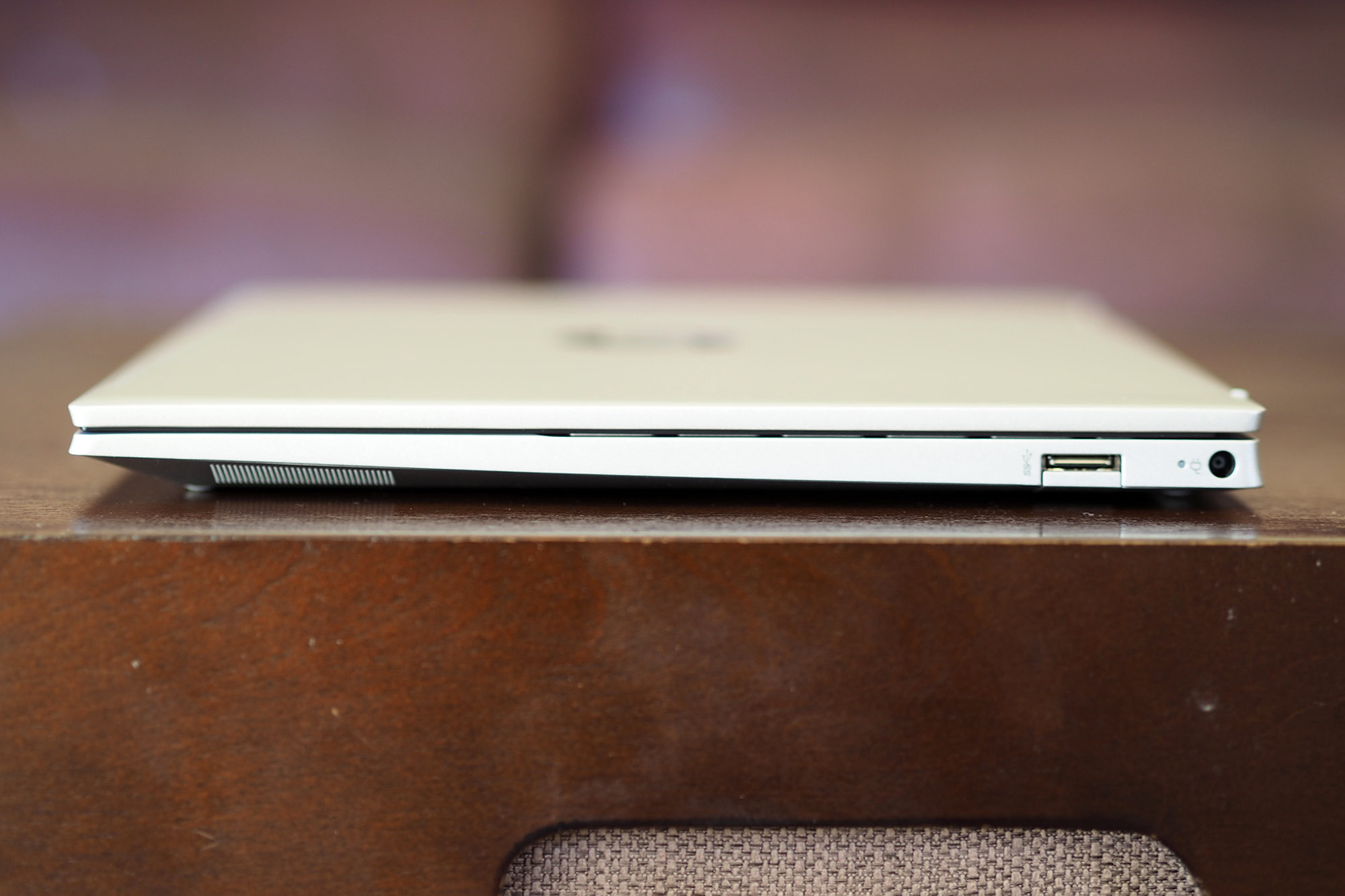
- Mostly solid build quality
- Excellent performance
- Very good battery life
- Extremely lightweight
- Minimalist good looks
- Keyboard is a little rough
- Lid is too bendable
Lightweight laptops usually come with compromises. Clunky performance and flimsy build quality are common.
HP’s new Pavilion Aero 13 attempts to resolve those misconceptions. Despite being just 2.18 pounds (and technically categorized as a budget laptop), the HP Pavilion Aero 13 is a fast, well-made, and surprisingly premium little laptop.
I reviewed a $1,000 midrange configuration of the Pavilion Aero 13 equipped with an eight-core AMD Ryzen 7 5800U CPU and a modern 16:10 Full HD+ (1,920 x 1,200) IPS display. Most buyers will be interested in the $750 base configuration with a Ryzen 5 5600U and half the RAM and storage.
But regardless of which you pick, this isn’t your father’s budget-level Pavilion.
Design
The Pavilion Aero 13 is the first in its line to be constructed of a magnesium-aluminum alloy throughout the chassis. That makes it extremely light at just 2.18 pounds — in fact, it’s the lightest consumer laptop HP has ever produced. The HP Envy 13 is a little wider and a little shallower, and it’s the same thickness at 0.67 inches, but it weighs 2.88 pounds.
The previous-generation Pavilion 13 was larger in all dimensions, 0.70 inches thick, and weighed 2.71 pounds — without featuring an all-metal design. Clearly, the Pavilion Aero 13 stands out among HP’s thin-and-light 13-inch laptops.

It also beats out the best 13-inch laptop around, the distinctly premium Dell XPS 13, at least in weight. That laptop is 0.58 inches thick, weighs 2.8 pounds, and is a little shallower even given its own 16:10 display. The reason: HP built a bit of a lift into the hinge that props up the keyboard at an angle for better typing and improved airflow, and so the Pavilion Aero 13’s chin is larger than it appears when the lid is open. A closer competitor is the Asus ZenBook 13 OLED ($1,000 with 16GB of RAM, a 1TB SSD, and an OLED display), which is a bit larger in width and depth and heavier at 2.5 pounds, but it comes in at just 0.55 inches thick.
There’s a cost to that lightweight metal alloy. While the Pavilion Aero 13’s bottom chassis has only a slight bit of give with a good squeeze, the lid is quite bendable. That’s because the metal is not only more pliable, but it’s also rather thin. Build quality is one area where the Pavilion Aero 13 shows off its budget pedigree — though it’s not bad by any means. Still, a more premium laptop like the XPS 13 or HP’s Spectre x360 13 gives off the impression of rock-solid rigidity that the Pavilion can’t match.
The ZenBook 13 OLED also has some give to it, but it’s difficult to say which is more solidly built without comparing them side by side. I’ll note that the Pavilion Aero 13’s hinge is excellent — you can open the lid with one hand, and there’s only the tiniest bit of wobble while typing.
Aesthetically, the Pavilion Aero 13 has a modern look that’s reminiscent of the Envy line. It’s a minimalist design with clean lines and angles that’s available in four colors — the Natural Silver of my review unit, Pale Rose Gold, Warm Gold, and Ceramic White. Whichever color scheme you select, you’ll get a simple and attractive look without being overbearing. It’s also modern thanks to the small display bezels that result in a 90% screen-to-body ratio. The XPS 13 and Spectre x360 13 are more standout machines, but there’s plenty of room for a laptop that looks this good without drawing attention to itself.
Connectivity is mixed, with a full-size HDMI 2.0 port, USB-A port, and USB-C port along the left-hand side and a second USB-A port on the right-hand side. That’s great legacy support, but due to the AMD chipset, there’s no Thunderbolt support. There’s also no SD card reader, which is disappointing. Wi-Fi 6 and Bluetooth 5.2 provide wireless connectivity.
Performance

Equipped with an 8-core/16-thread AMD Ryzen 7 5800U CPU, along with 16GB of RAM and a 512GB PCIe solid-state drive (SSD), the Pavilion Aero 13 promises to be quite the performer. AMD’s chip is faster in CPU-intensive tasks than Intel’s 4-core/8-thread 11th-gen Core i7-1185G7, which is the top of the line among Intel’s consumer thin-and-light processors.
These extra cores matter most to anyone who will use applications like creative software that push the CPU particularly hard. Video editing jumps out here, and according to our benchmarks, the Pavilion Aero 13 provides a surprising amount of power in such a light package.
The Pavilion Aero 13 is the fastest laptop in our comparison group and neck and neck with other laptops equipped with the Ryzen 7 5800U, such as the Asus ZenBook 13 OLED. These two swapped places from benchmark to benchmark, with the HP leading in Handbrake with an excellent score of under two minutes to encode our 420MB test video to H.265 and in Cinebench R23. These benchmarks demonstrate how well a laptop will perform not just in creative tasks like video rendering and display, but in most tasks that push the CPU for a more extended time. They show not just processor performance but also how well a laptop’s thermal design keeps the CPU running at full speed.
The HP Pavilion Aero 13’s performance was impressive across the board.
At the same time, the ZenBook 13 OLED pulled ahead in Geekbench 5 and the PCMark 10 Complete score, tests that show how well a laptop will perform in a mix of productivity work such as web browsing, videoconferencing, and Office applications, as well as while multitasking. The difference wasn’t as great, and so it would be fair to call the two laptops evenly matched. And as you can see in the table below, both
Simply put, the Pavilion Aero 13 was impressive across the board. If you’re running the CPU-intensive applications mentioned above, then you’ll find few thin-and-light laptops that can keep up. The Pavilion Aero 13 was plenty quick during my testing, handling everything I threw at it without hesitation. I can strongly recommend this incredibly light laptop based on its performance alone.
| Geekbench (single/multi) | Handbrake (seconds) |
Cinebench R23 (single/multi) | PCMark 10 | 3DMark Time Spy | |
| HP Pavilion Aero 13 (Ryzen 7 5800U) |
1373/6430 | 112 | 1381/8304 | 5756 | 1212 |
| Asus ZenBook 13 OLED (Ryzen 7 5800U) |
1423 / 6758 | 124 | 1171 / 7824 | 6034 | 1342 |
| Dell XPS 13 (Core i7-1185G7) | 1549 / 5431 | 204 | 1399 / 4585 | n/a | 1380 |
| HP Spectre x360 14 (Core i7-1165G7) | 1214 / 4117 | 236 | 1389 / 3941 | 4728 | 1457 |
| Razer Book 13 (Core i7-1165G7) | 1548 / 5374 | 210 | 1508 / 4519 | 4878 | 1776 |
| MacBook Pro 13 (M1) | 1707 / 7337 | n/a | 1487 / 7547 | n/a | n/a |
The Ryzen chips don’t dominate in gaming performance, however. The Pavilion Aero 13 achieved the lowest 3DMark Time Spy test among our comparison group, and it wasn’t impressive in our test game, Fortnite.
It hit 29 frames per second (fps) at 1080p and high graphics and 15 fps with epic graphics turned on. That’s about the same as you’ll get from Intel Iris Xe integrated graphics, and not enough for anything but older titles or newer titles with the resolution and graphical detail turned down.
Display
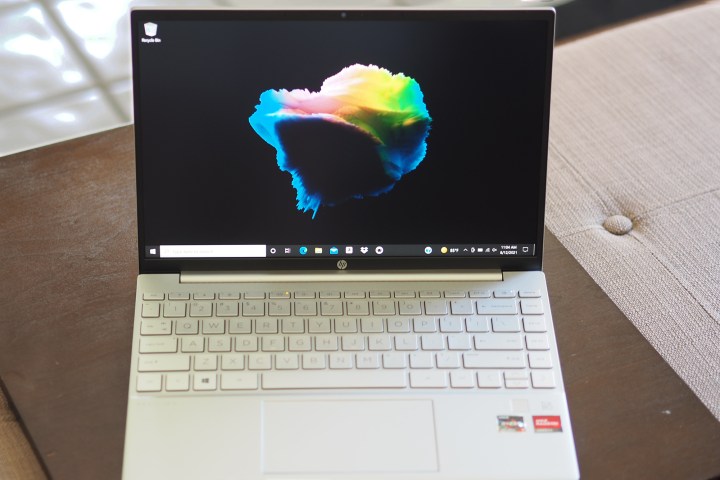
HP migrated the taller 16:10 aspect ratio downward in the Pavilion brand, equipping the Pavilion Aero 13 with a 13.3-inch 16:10 IPS panel in one of two resolutions. You can choose from Full HD+ (1,920 x 1,200), which my review unit has, or QHD+ (2,560 x 1,600) displays.
I was impressed with the display, which was so much better than you’ll typically find on a Pavilion or other ostensibly budget laptop. Again, this is a $1,000 machine, and so it’s reasonable to expect a good display — and HP delivered. My subjective experience matched my objective results, which I’ll outline in a moment, with colors that popped without oversaturation and appeared accurate enough for all but the most discerning creative professionals. While the contrast came in lower than I like in its absolute number, black text still stood out on white backgrounds — important for anyone who works with words or numbers on the screen.
The HP Pavilion Aero 13’s ultra-bright display holds up particularly well under direct sunlight.
According to my colorimeter, the Pavilion Aero 13’s display was mostly a quality premium display. It was very bright at 437 nits, well beyond our 300-nit threshold and close to the Dell XPS 13 Full HD+ display’s 458 nits. The Asus ZenBook 13’s OLED panel put out 397 nits of brightness by comparison. Any of these displays might even be usable in direct sunlight, but the Pavilion Aero 13 holds up particularly well. The Pavilion Aero 13’s one disappointment was its contrast ratio, which came in at just 830:1 — below our 1,000:1 threshold for the best displays. The XPS 13 was much better at 1350:1, while the ZenBook 13 OLED enjoyed that display technology’s extreme contrast at 396,690:1.
The Pavilion Aero 13’s color saturation was average at 77% of AdobeRGB and 99% of sRGB, slightly better than the premium average. The XPS 13 came in at 75% and 98%, while the ZenBook 13 OLED again benefitted from the display technology with an excellent 100% of both color spaces. The HP’s colors were reasonably accurate with a DeltaE of 1.8 (less than 1.0 is considered excellent), with the XPS 13 at 1.36 and the ZenBook 13 OLED at a phenomenal 0.49.
The audio wasn’t quite up to the same standard. Volume was too low, although there was no distortion when turned all the way up. Mids and highs were clear, but there was zero bass, leaving the sound a bit lifeless. It’s fine for system sounds and the occasional YouTube video, but you’ll want earphones or Bluetooth speakers for bingeing Netflix or listening to music.
Keyboard and touchpad
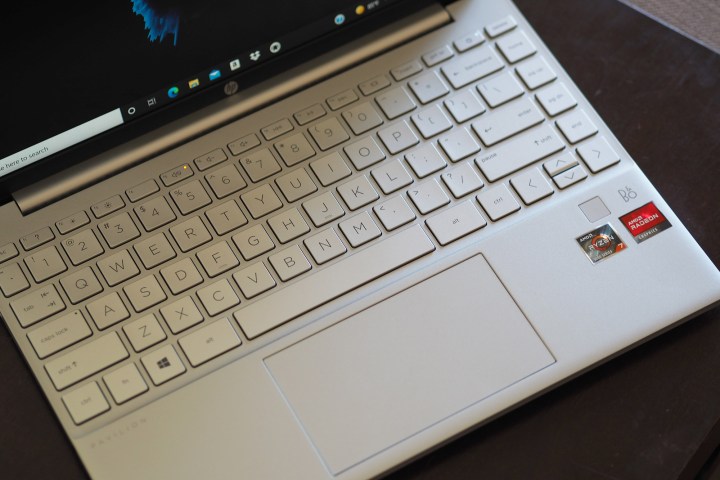
The Pavilion Aero 13 has a keyboard that looks like the one on the Spectre and the latest Envy laptops. It has good spacing with nicely sized keycaps and the same row of positional keys along the right side. But it doesn’t use the same mechanism that I’ve grown accustomed to. There’s good travel but without the precise bottoming action and clickiness that you get with HP’s higher-end machines.
The Spectre keyboard is my favorite among Windows 10 laptops, and the Pavilion Aero 13’s doesn’t stack up. It’s better than many budget
The touchpad is better — it’s 23% larger than the previous version’s and takes up most of the available space on the keyboard deck. It’s bigger than the touchpad on the Spectre x360 13 but not as big as the Spectre x360 14’s version. It has a smooth surface and supports Microsoft’s Precision touchpad drivers, so Windows 10 multitouch gestures were well-supported. There’s no touch display option, and that’s a bummer because I’m not too fond of non-touch displays — not everyone feels the same, though, and so that may not be a deal-breaker for most buyers.
Windows 10 Hello support is provided by a fingerprint reader on the keyboard deck, and it worked fine. I could log in without my password without muss and fuss, which is all you want from the feature.
Battery life
The Pavilion Aero 13 is equipped with a 43 watt-hour battery, which is a little small for a 13-inch laptop. I’ve seen mixed results with Ryzen battery life, so even with the Full HD+ display, I wasn’t expecting great longevity.
I was mostly encouraged in my benchmark testing. The Pavilion Aero 13 lasted for 10.5 hours in our web-browsing test, which is a solid result. The Dell XPS 13 Full HD+ made it to 8.5 hours, while the Asus ZenBook 13 OLED achieved an astounding 15.7 hours even with its OLED display. In our video test that loops through a local 1080p trailer, the Pavilion Aero 13 hit just over 10.5 hours again, with the XPS 13 at 12 hours and the ZenBook 13 OLED at 15.5 hours. I’ve noticed that, unlike Intel laptops, Ryzen machines don’t always show as much of an increase from web browsing to the video test.
In the PCMark 10 Applications battery test, the Pavilion Aero 13 almost made it to 11.5 hours, a strong score that’s near the top of our database. The XPS 13 came in at just under 10 hours, and we didn’t test the ZenBook 13 OLED with this benchmark. The Pavilion Aero 13 managed just 94 minutes in the PCMark 10 Gaming battery test, near the bottom of our database, while the XPS 13 almost made it to four hours. This PCMark battery test, though, depends a lot on how aggressively a laptop runs on battery, and so it’s likely that the HP maintained full speed while the Dell throttled back during the test.
Overall, the Pavilion Aero 13 achieved all-day battery life and then some. You’ll be able to pick up some work in the evening without plugging in, or perhaps binge Netflix for a few hours. That’s a commendable result given the laptop’s light weight, partly thanks to the smaller battery capacity.
Our take
HP pushed a few premium features down into the Pavilion line with the Pavilion Aero 13, while pumping up the price. The all-metal chassis and 16:10 display aspect ratio are welcome additions and give the Pavilion Aero 13 some justification for its $1,000 price. Its performance and battery life were also good enough to make the price seem reasonable, even if it’s more than we expect from a machine that’s supposed to be a budget option.
Toss in the extremely lightweight nature of the Pavilion Aero 13, and you have a very compelling option in the 13-inch space. Anyone looking for a laptop in this class would be happy with the Pavilion Aero 13, even considering midrange and premium alternatives.
Any alternatives?
I’ll mention the HP Envy 13 not because it’s a great alternative but because for the same $1,000, you get a laptop with less performance and an old-school 16:9 display. It points out how aggressively HP is positioning the superior Pavilion Aero 13 against the rest of its lineup.
The Asus ZenBook 13 OLED is a more competitive alternative that also costs $1,000. It runs the same CPU but includes a larger 1TB SSD and an OLED display.
Finally, you could opt for the Dell XPS 13, which is more expensive but also more premium. You’ll get a better build quality, a slightly better display, and a more elegant look and feel.
How long will it last?
The Pavilion Aero 13 has a slightly flexible lid, but otherwise, it’s a well-built and well-equipped laptop that should last for years of typical use. The one-year warranty is standard but, as usual, disappointing.
Should you buy it?
Yes. The Pavilion Aero 13 isn’t just — or even mostly — for budget laptop buyers. It’s a great machine for anyone looking at a 13-inch laptop.
Editors' Recommendations
- HP Envy x360 13 vs. Dell XPS 13: the best tiny laptop?
- AMD and Intel duke it out in the GPD Win Max 2, and there’s a clear winner
- New AMD laptops bring up to 30 hours of battery life
- Dell XPS 13 vs. HP Spectre x360 13
- Microsoft Surface Laptop 3 vs. HP Spectre x360 13

